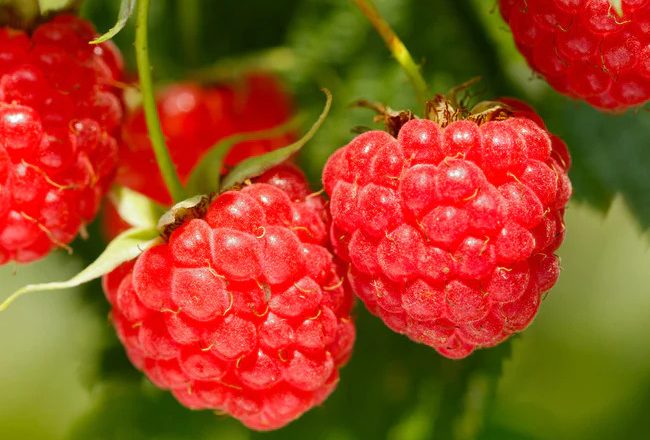Planting and caring for raspberry plants is really quite easy once you know a few secrets about raspberry plants. Good healthy raspberry plants will provide you with an ample supply of sweet, delicious fruit.
A few preparation steps are required before you can begin planting and caring for your raspberry plants. You must decide where you want to raise your raspberry plants. The soil must be well drained.
In other words, the area should quickly dry after rain and not hold standing water. The plants must have enough room for their roots to grow up to 4 feet long.
Raspberry plants require 1 to 2 inches of water per week and full exposure to sunlight. The area where you plant and care for your raspberry plants should be away from buildings or trees, giving the plant well-circulated air, while avoiding exposure to extreme winds.

It is best to avoid areas where wild raspberry and blackberry plants are growing, and shy away from land where potatoes, peppers, tomatoes, or eggplants were grown within the last four years. These extra efforts will help to prevent the spread of Verticillium wilt, which can destroy your plants.
A year before planting your raspberry plants you should prepare the soil. This consists of destroying annual weeds and adding compost to your soil. Testing the pH or acidity of your soil would also be a good idea.
The area you are going to plant and care for your raspberry plants should have a pH of approximately 5.8 -6.5. If the pH of your soil is high or low you can add nutrients to regulate the pH.
Your local county extension office can usually do a soil test for you, and they will recommend any amendments that your soil may need.
Once you have chosen and prepared an area to plant and care for your raspberry plants you are ready to plant.
Purchasing your raspberry plants from a reliable source is advisable to ensure disease-free plants. Fertilizer should be spread on the planting site and mixed into the soil before planting. 10-10-10 gardening fertilizer would be suitable. Make sure you follow the recommendations on the bag.
Raspberry plants should be planted in the spring, after there is no longer worry of frost. When digging a hole you should keep in mind that you want the plant to set at the same depth as it was in the nursery.
Once the plant has been placed in the hole you need to fill the hole in with extra dirt, packing the soil firmly around the roots of the plant. The newly planted raspberry plants should then be well watered.
Once you have your raspberry plants in the ground it is now time to begin caring for your plants. The area should remain weed free and once a week you need to thoroughly water your plants if there hasn’t been sufficient rainfall.
If you decide to mulch you should be aware that your plants will be more susceptible to winter injury because the mulch creates a delay in the plant hardening and going dormant in late fall. You may spread sawdust, bark, pine needles, or rotted leaves at the base of the plants. These organic mulches are quite compatible with your raspberry plants.
Planting and caring for raspberry plants also requires fertilization each year with a 10-10-10 gardening fertilizer. Fertilizer should be applied twice a year, initially as the plants begin to bloom in order to stimulate plant growth, increase berry size and increase the total amount of berries produced.
After fruit harvest the raspberry plant should be fertilized again. This will stimulate cane growth for the next season. For every 100 feet of row you will use ten pounds of fertilizer throughout the season; five pounds at blooming time and another five pounds after harvest.
During the first year your raspberry plants will not produce any fruit. They are in the process of growing and collecting nutrients. Their slender but strong stems, known as canes, last for two years.
The canes produced during the first year of growth are called primocanes and during their second year of growth, when they bloom and produce fruit, they are known as floricanes.
Black and purple raspberries are different from the red raspberries when it comes to pruning. The black and purple raspberries should be pruned three times a year. First in about mid March when you will be cutting back the lateral branches to 8 to 10 inches.
The second pruning is done in summer and is known as tipping. When the canes on black raspberries reach a height of 24 inches and the canes on the purple raspberries reach 30 inches you will need to trim the top two to three inches of the canes. Finally, the canes that produced fruit will need to be removed after harvest.
Red raspberry plants are either summer bearing or everbearing. It is important to know whether your plants are summer bearing or everbearing before determining how to prune them.
Everbearing red raspberries, also known as fall-bearing or primocane-bearing raspberries, produce a fall crop of berries in late summer on the top third of the cane, and a second crop the next June on the bottom two-thirds of the cane.
Everbearing raspberries can be grown for both these crops or they can be pruned so that only the late summer crop is harvested. For the largest yield from your everbearing raspberries, the canes can be cut back to the ground and removed in late fall or early spring.
This will eliminate the June crop but the late summer crop will be earlier and more productive. This is recommended in areas where raspberry diseases tend to be a problem.
You will prune your everbearing raspberries differently if you wish to harvest both the spring and late summer crops. Following the harvest of the late summer crop, the top third of the cane will die back and it should be pruned off in early spring before new growth appears.
he lower part of the can will then produce fruit in early summer and new primocanes will grow up from the roots to produce the late summer crop. After the canes have produced their crops they should be pruned to the ground and removed from the raspberry patch.
Summer red raspberries need to be pruned twice a year. They should be pruned in the early spring and then immediately after harvest.
In late March or early April you want to remove all weak and dead canes and cut back any canes over 5 feet long. After harvest you will be removing all the floricanes that produced fruit, leaving behind the primocanes for next year’s crop.

When the berries are easily separated from the core they are ready to pick. Black raspberries never become easy to remove so you must pay close attention to their color and taste when deciding the proper time for them to be picked.
If birds are eating your raspberries before you can pick them, you may need to cover the plants with bird netting to avoid losing your crop to hungry birds. Bird netting can be purchased at many garden centers or garden catalogs.
Fresh raspberries are tasty, nutritious and very easy to grow. A healthy stand of raspberry plants will provide many years of fresh berries and delicious desserts for your family.
source : Mike McGroarty



